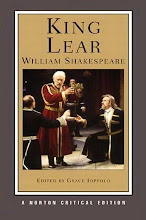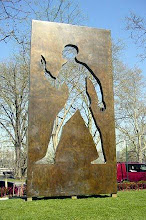A really general plot summary is: the main character is an African-American man who is betrayed, sometimes homesick, and invisible, living in a world controlled by white Americans.
O.K. So the villagers in the Country of the Blind were blinded by their blindness (they had adapted so well to their disability that they thought there disability to be normal and that anyone else was not). In Invisible Man by Ralph Ellison the same “set up” occurs, where the white population of the world is blinded by racism, which results in their inability to see and believe that everyone is the same.
“The invisibility to which I refer occurs because of a peculiar disposition of the eyes of those with whom I come in contact. A matter of the construction of their inner eyes, those eyes with which they look through their physical eyes upon reality.” (3)
Invisible Man is a story told through the antagonist the “invisible man.” In the prologue the “invisible man” explains to the reader why he believes himself to be invisible:
“I am invisible, understand, simply because people refuse to see me.” (3)
He also tells the reader that it is not his disadvantage to be invisible but his invisibility may be a disadvantage for others. He strengthens his argument with a personal experience, an experience where he nearly beat a guy to death all because the man had not seen him. In the end of the novel, at the end of the novel, in the epilogue, the “invisible man” reiterates this same concept to the reader:
"You won't believe in my invisibility and you'll fail to see how any principle that applies to you could apply to me. You'll fail to see it even though death waits for both of us if you don't." (580)
There are a two scenes that really stick out when it comes to blindness and the truth. The first is one of the first scenes in the novel, the famous (or infamous) Battle Royal. During the Battle Royal (which the invisible man had no idea he would be partaking in, rather he thought he would just be giving a speech), the contestants which are all African Americans are blindfolded. The audience is a rowdy group of powerful white American’s, who are watching simply for the fun. Though the inequality of the fight is apparent, the blindfolds that are used poke at the bigger picture. The blindfolds represent the contestant’s blindness to the truth of their standing in society, their powerlessness and the strong racism influence.
Another scene is the speech given by the invisible man in chapter sixteen. The blindness motif is used again, as the invisible man steps onto stage to give his speech he becomes blinded by the bright lights and can no longer see the audience. His blinded speech speaks about the blinded society:
“They think we’re blind--un-commonly blind. And I don’t wonder. Think about it, they’ve dispossessed us each of one eye from the day we’re born. So now we can only see in straight white lines.” (343)
His speech grasps the concept of the Battle Royal scene, that the white American’s have taken away their sight so that they become submissive and vulnerable. But his speech goes on to say that that does not have to be the case, because it has been revealed that:
“Up to now we’ve been like a couple of one-eyed men walking down opposite sides of the street. Someone starts throwing brick and we start blaming each other and fighting among ourselves. But we’re mistaken! Because there’s a third party present.” (344)
And we all know who the third party is…
- - -
So far there has been something in the way of people seeing the truth. The first was blindness itself and the second racism. Next I will discuss how actual blindness results in the loss of loyal children in King Lear.



No comments:
Post a Comment